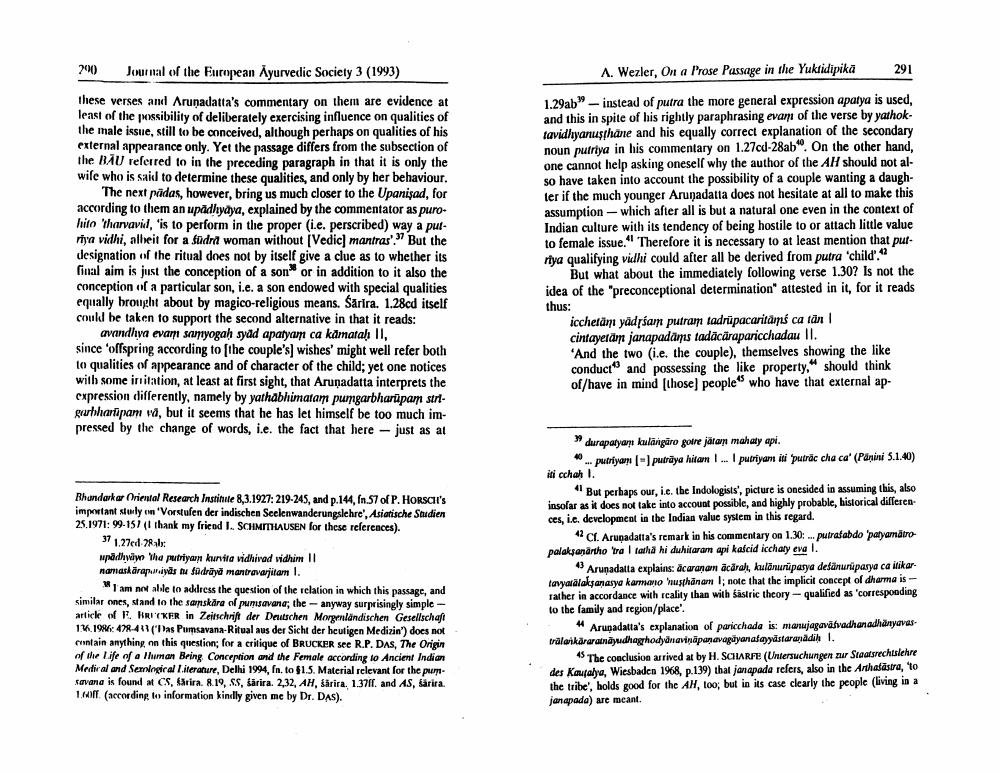________________
Journal of the European Ayurvedic Society 3 (1993)
these verses and Arunadatta's commentary on them are evidence at least of the possibility of deliberately exercising influence on qualities of the male issue, still to be conceived, although perhaps on qualities of his external appearance only. Yet the passage differs from the subsection of the BAU referred to in the preceding paragraph in that it is only the wife who is said to determine these qualities, and only by her behaviour.
The next padas, however, bring us much closer to the Upanisad, for according to them an upadhyaya, explained by the commentator as purohito 'tharvavid, 'is to perform in the proper (i.e. perscribed) way a putriya vidhi, albeit for a fudra woman without [Vedic] mantras'." But the designation of the ritual does not by itself give a clue as to whether its final aim is just the conception of a son or in addition to it also the conception of a particular son, i.e. a son endowed with special qualities equally brought about by magico-religious means. Sarira. 1.28cd itself could be taken to support the second alternative in that it reads:
avandhya evam samyogah syad apatyam ca kamataḥ 11, since 'offspring according to [the couple's] wishes' might well refer both to qualities of appearance and of character of the child; yet one notices with some irritation, at least at first sight, that Arunadatta interprets the expression differently, namely by yathabhimatam pumgarbharüpam strlgarbharüpam va, but it seems that he has let himself be too much impressed by the change of words, i.e. the fact that here just as at
200
Bhandarkar Oriental Research Institute 8,3.1927: 219-245, and p.144, fn.57 of P. HORSCH's important study on 'Vorstufen der indischen Seelenwanderungslehre', Asiatische Studien 25.1971: 99-157 (I thank my friend I. SCHMITHAUSEN for these references).
37
1.27ed-28ab:
upadhyayo ha putriyam kurvita vidhivad vidhim || namaskarapuriyās tu fūdrāyā mantravarjitam 1.
381 am not able to address the question of the relation in which this passage, and similar ones, stand to the samskära of pumisavana; the - anyway surprisingly simplearticle of F. BRICKER in Zeitschrift der Deutschen Morgenländischen Gesellschaft 136.1986: 478-433 (Das Pumsavana-Ritual aus der Sicht der heutigen Medizin') does not contain anything on this question; for a critique of BRUCKER see R.P. DAS, The Origin of the Life of a Human Bring Conception and the Female according to Ancient Indian Medical and Sexological Literature, Delhi 1994, fn. to $1.5. Material relevant for the pumsavana is found at CS, ärira. 8.19, SS, särira. 2,32, AH, śärira, 1.37ff. and AS, sarira. 1.60ff. (according to information kindly given me by Dr. DAS).
A. Wezler, On a Prose Passage in the Yuktidipikā
1.29ab" instead of putra the more general expression apatya is used, and this in spite of his rightly paraphrasing evam of the verse by yathoktavidhyanusthane and his equally correct explanation of the secondary noun putriya in his commentary on 1.27cd-28ab0. On the other hand, one cannot help asking oneself why the author of the AH should not also have taken into account the possibility of a couple wanting a daughter if the much younger Arunadatta does not hesitate at all to make this assumption which after all is but a natural one even in the context of Indian culture with its tendency of being hostile to or attach little value to female issue." Therefore it is necessary to at least mention that putriya qualifying vidhi could after all be derived from putra 'child'.""
But what about the immediately following verse 1.30? Is not the idea of the "preconceptional determination" attested in it, for it reads thus:
icchetam yadṛśam putram tadrupacaritamś ca tän cintayetam janapadams tadacaraparicchadau II.
'And the two (i.e. the couple), themselves showing the like conduct and possessing the like property," should think of/have in mind [those] people who have that external ap
291
durapatyam kulängaro goire jätam mahaty api.
... putriyam [-] putraya hitam I... I putriyam iti putrac cha ca' (Panini 5.1.40)
iti cchah I.
41 But perhaps our, i.e. the Indologists', picture is onesided in assuming this, also insofar as it does not take into account possible, and highly probable, historical differen ces, i.e. development in the Indian value system in this regard.
42 Cf. Arupadatta's remark in his commentary on 1.30: ... putratabdo 'patyamatropalaksanartho 'tra | tatha hi duhitaram api kalcid icchaty eva 1.
43 Arunadatta explains: acaraṇam acaraḥ, kulānurüpasya defänurüpasya ca ilikartavyatalaksanasya karmano nusthanam I; note that the implicit concept of dharma israther in accordance with reality than with śastric theory-qualified as 'corresponding to the family and region/place'.
44
Arupadatta's explanation of paricchada is: manujagavatvadhanadhanyavasträlankäraratnayudhaghodyänavinäpaṇavagayanafayyastaraṇādiḥ 1.
45 The conclusion arrived at by H. SCHARFE (Untersuchungen zur Staatsrechtslehre des Kautalya, Wiesbaden 1968, p.139) that janapada refers, also in the Arthatastra, "to the tribe', holds good for the AH, too, but in its case clearly the people (living in a janapada) are meant.




